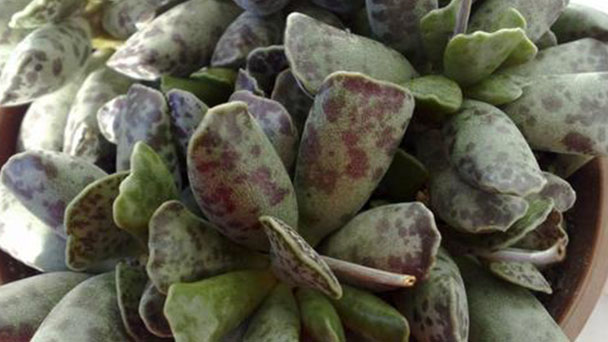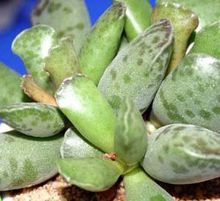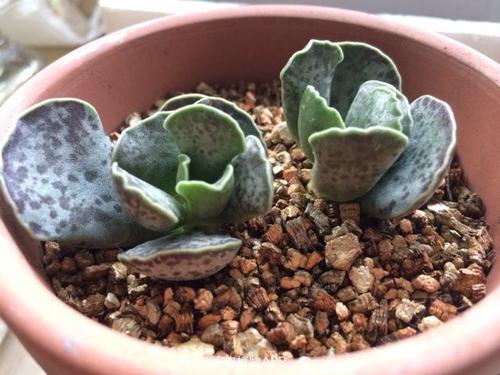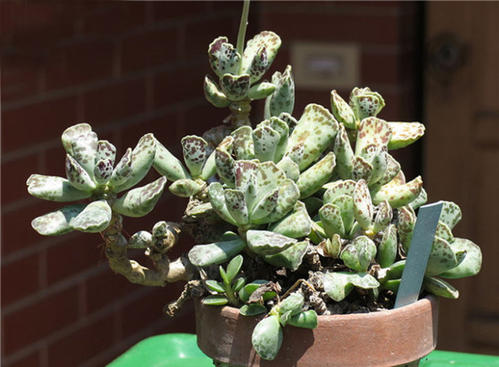Adromischus Cooperi (Plover Egg Plant) Profile
Written by Maggie
Dec 06 2021

The plover egg plant, scientific name Adromischus cooperi, is a perennial succulent that grows in a sunny, cool, dry environment. The plover egg plant can also grow normally in semi-shade. Too much shade will cause poor growth.
Plover egg plant picture

Morphological characteristics of plover egg plant
Adromischus cooperi is short, short stem grayish-brown. Leaves are basically long cylindrical, the lower part of the very long section is almost cylindrical, the upper part is slightly wide, slightly flat, nearly ovoid, 2.5 ~ 5 cm long, 1 ~ 2 cm wide, the back of the leaf is round and convex, the front side is flat, the top leaf margin has wavy wrinkles, the epidermis is hairless, shiny, the leaf color is grey-green with dark purple spots. Inflorescences of The plover egg plant are 25 cm tall, cylinder cylindrical, 1 cm long, green above, purple below, corolla 5-lobed, purple, margin white.
Ecological habits of plover egg plant
The plover egg plant basically stops growing in summer when the temperature is high. It is advisable to keep ventilation, avoid hot sun exposure, and pay attention to watering sparingly. Winter temperature requirements are not high, more than 7℃ can normal growth, should be appropriate watering, to keep the soil moderately moist, and give sufficient sunshine; If you water in moderation, make the plover egg succulent dormant, can also withstand the low temperature of 3℃. The growing season for the cold season should master the "dry thoroughly pouring" watering principle, prevent soil water, otherwise easy to rot.
Every 20 days or so can be applied once "low nitrogen high phosphorus, potassium" compound fertilizer or cooked rarefied liquid fertilizer. If there is dust on the leaf surface, The Adromischus cooperi can be sprayed with water at the appropriate temperature to wash. Every 1 ~ 2 years for a basin, the basin soil can be mixed with some leaf rot soil vermiculite, coarse sand or perlite, if add some vegetation ash and rotten bone powder effect is better.
Distribution area of the plover egg plant
Adapted area: Cape province of South Africa and Namibia.

The plover egg plant propagation methods
The propagation of Adromischus cooperi can be used for cutting leaves, except in summer when the temperature is high, more than 10 can be carried out, select robust and substantial leaves, air 1~2 days later, and put them on the soil, and soon they will take root and germinate, but it is not suitable for premature transplantation.
The plover egg plant growing methods
The plover egg succulent stops growing at high temperatures in summer and should be ventilated.
Prevent the scorching sun insolation, pay attention to water. Winter temperature requirements are not high, more than 7℃ can normal growth, The plover egg plant should be appropriate watering, to keep the soil moderately moist, and give sufficient sunshine; If you water in moderation, make The plover egg plant (Adromischus cooperi) dormant, can also withstand the low temperature of 3℃. The growing season for the cold season should master the "dry thoroughly pouring" watering principle, prevent soil water, otherwise easy to rot. Every 20 days or so can be applied once "low nitrogen high phosphorus, potassium" compound fertilizer or cooked rarefied liquid fertilizer. If there is dust on the leaf surface, The plover egg succulent can be sprayed with water at the appropriate temperature to wash. Every 1 ~ 2 years for a basin, the basin soil can be mixed with some leaf rot soil vermiculite, coarse sand or perlite, if add some vegetation ash and rotten bone powder effect is better.
Garden use of the plover egg plant
The Adromischus cooperi has a unique leaf shape, unique color, small plant shape and shallow root system. The plover egg plant (Adromischus cooperi) should be planted in small and shallow flowerpots to decorate windowsills, desks and other places with unique interest.

Latest Updated
- Benefits of Bugleweed - 7 Science-backed Health Benefits
- Bugleweed Dangers & Side Effects - Is It Poisonous?
- How to Plant Evergreen Trees - What You Should Know
- When to Plant Evergreens - Grow Guide for Evergreen Trees
- 12 Wonderful Evergreen Shrubs for Your Garden
- 12 Popular Evergreen Plants with Pictures for Beginners
- When And How To Prune A Lilac Bush Like a Pro
- How to Grow & Care for Lilac Vine (Hardenbergia Violacea)
- Japanese Lilac Tree (Syringa Reticulata) Care & Propagation Guide
- Shumard Oak Pros and Cons - What to Know
Popular Articles
- Winter maintenance of Antirrhinum Majus
- How to Grow Terminalia Mantaly Tree
- How to Grow and Care for Crossostephium Chinense
- How to grow Antirrhinum Majus in spring
- Peristeria Elata (Dove Orchid) Profile: Info & Care Guide
- Underwatered Snake Plant (Sansevieria Trifasciata) - Signs And How To Fix
- How to Care for Brazilian Jasmine Plant (Mandevilla Sanderi)
- How to Grow & Care for Graptopetalum Purple Delight in Summer
- Rosa Chinensis (China Rose): Plant Growing & Care Tips
- How to Care for Baby Sun Rose (Aptenia Cordifolia)